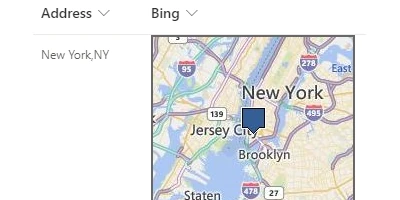Embed Bing Maps in SharePoint Lists - June 7, 2025
Enhancing SharePoint with Bing Maps IntegrationTracking and managing address information efficiently is a critical component of many organizational processes. Whether managing customer data, site locations, or travel destinations, housing this information in SharePoint lists is a common practice. Simply storing addresses, however, can sometimes fail to deliver insightful or actionable data. Herein lies the potential of visualizing address information, a task made infinitely more straightforward with the Bing Maps template available at SharePointDashboards.com. This template not only transforms routine data into engaging visual displays but seamlessly integrates into existing SharePoint views.Charting and Visual Status IndicatorsThe need for effective visualization in the corporate environment cannot be overemphasized. Visual status indicators play a significant role in assessing project progress and status at a glance. By leveraging the Bing Maps template, SharePoint users can transform traditional list views into dynamic maps, offering an instant visual cue about the location-related data. This form of charting considerably enhances the interpretation of data and supports informed decision-making processes by management.Utilization in Project and Employee ManagementSharePoint is a powerful tool in both project management and employee management, primarily due to its capability to manage and organize vast amounts of data. Incorporating the Bing Maps template adds depth to these functionalities by visually representing employee locations, site visits, and project locales. This transformation aids managers in tracking project progress, identifying logistical issues, and ensuring resources are aptly deployed.SharePoint Setup with Simple Copy and PasteImplementing the Bing Maps template into your SharePoint setup is a straightforward process and requires no installation. Users can customize their settings, then copy and paste the template directly into the desired SharePoint list, making it accessible to employees across various departments without the need for advanced technical skills. The templates, which also include Google Maps options, are designed to accommodate diverse organizational needs. Furthermore, SharePointDashboards.com offers a hassle-free signup process along with 21 free templates to help users get started with their mapping journey.SharePoint JSON Formatting and List View IntegrationCentral to the integration of map templates in SharePoint lists is JSON (JavaScript Object Notation) formatting. JSON formatting allows users to apply a specific template to a SharePoint list view, altering the visualization of data seamlessly. By copying the JSON script provided within the template and applying it to a SharePoint address column, organizations can enable map visualizations, adding a layer of depth and utility to otherwise mundane list views. The clarity offered by such enhancements is invaluable for teams that rely on clear, fast, and actionable insights.Practical Use Case ScenariosThe power of visualizing data through maps becomes evident in various practical scenarios. For instance, sales teams managing client portfolios across different regions can use these templates to pinpoint client clusters, optimize routes, and streamline visit schedules. Similarly, for logistics teams, real-time mapping of delivery sites can uncover inefficiencies and enhance planning strategies. In the realm of employee management, mapping employee residences or workplaces can assist in organizing shifts, developing regional assignments, or planning team-building events at central locations. This utility extends to managing distributed teams, where understanding geographical distribution can greatly influence communication plans and resource allocation.ConclusionIntegrating the Bing Maps template from SharePointDashboards.com into SharePoint lists elevates the utility of address information by visualizing it in engaging, interactive maps. This not only enriches data interpretation but also supports effective project and employee management. Offering a simple setup process, diverse template options, and a user-friendly interface, this tool is an invaluable addition to any organization looking to leverage the full potential of their data housed within SharePoint. With the added benefit of JSON formatting flexibility and a myriad of practical applications, this integration represents a significant stride towards more dynamic and accessible data management. Embrace this opportunity today and transform your organization's approach to data visualization and management.Watch a video to learn more:
|